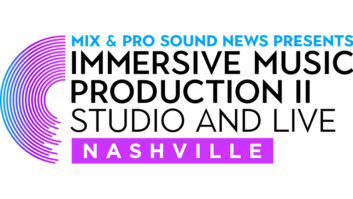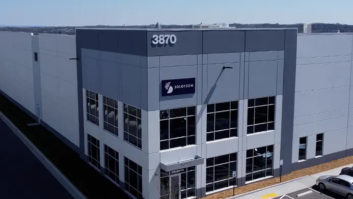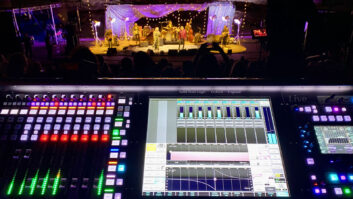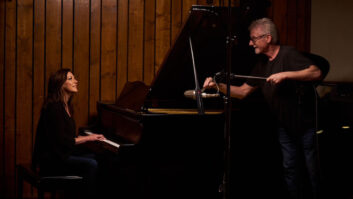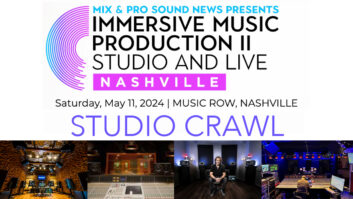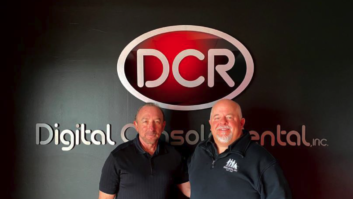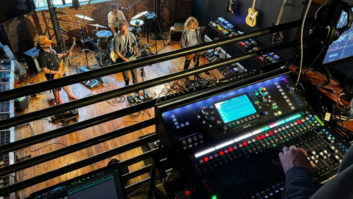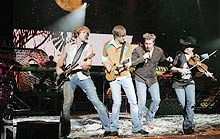
Twenty trucks carry Rascal Flatts’ expansive rig, including the P.A. system provided by Nashville’s Sound Image.
Photo: Steve Jennings
Any place where there’s a lot of live music, there’s sound reinforcement, and with all the activity originating from the Nashville Metro area, engineers and sound companies are as busy as the musicians. What’s interesting about the Nashville SR industry is not only the amount of activity, but also the diversity of the business: There is a modest club scene in the Nashville area, plus a few local arena-sized venues, but there are also a large number of major houses of worship, along with full-blown production rehearsal facilities. If that’s not enough, the folks we spoke with seem to stay busy providing national acts with tour support, as well as servicing the local corporate community with anything from P.A.-on-a-stick to full-blown concert systems for local festivals.
Engineer Jon Garber came to Nashville from South Dakota in 1997, initially “to do some studio work,” he explains. “Then Everett [Lybolt, Sound Image general manager] hired me to work with Brooks & Dunn as a system engineer. That lasted for three years, and then I worked with Toby Keith and Brad Paisley. About five years ago, I started working as the front-of-house engineer for Rascal Flatts, and it’s been a great ride. We started off with one truck and now we carry full production.”
When Garber says “full production,” he’s not kidding. The Rascal Flatts tour currently travels with one of the largest systems in the world, with 20 trucks on the road. The Sound Image-provided P.A. system includes Studer Vista 5 consoles for FOH and monitors, accommodating 80 inputs from the stage. Garber’s P.A. features 132 JBL VerTec cabinets for highs and lows, plus another 12 Wide-Line Sound Image cabinets for front-fill powered via Crown iTech 8000 amps.
For Nashville’s Sound Image, Rascal Flatts is one of many top touring clients, which also include Brooks & Dunn, Paisley and Keith. According to Lybolt, “There’s a lot going on in country music. The Nashville machine develops an artist whose career could quite possibly span a lifetime. How is that for longevity? Everybody benefits from that. For example, I have a 14-year relationship with Brooks & Dunn, and they were going at it for a few years before I came to town. I’ve been with Rascal since they got their record contract. I think after five years, they were doing arenas and now they’ll even be doing a few stadiums.
“There’s a high level of customer loyalty in this area, and that’s a good thing,” Lybolt continues. “Once an artist signs up with you, they tend to stay with you for the long haul. These same bands tour every year. It’s consistent business year after year after year, which is fantastic for us, as well as the other sound companies. I put gear on the road in the second week of January and most of the time it comes home right before Thanksgiving. Some of it stays out until right before Christmas. Fifteen years ago, I had no idea that it would be this good.”
Ralph Mastrangelo, executive VP of touring for ClairShowco Nashville, has also noticed consistent, long-term business in the Nashville-based touring market. “Many Nashville-based artists historically have made their living touring,” he says. “Even when record sales were high, they would tour 40-plus weeks a year. They don’t go away for two years, creating a situation where personnel changes and you have to re-establish your relationship. Unless they can’t afford to carry gear anymore or something strange happens, it is a constant, loyal client base for everyone.”
According to Mastrangelo — whose company’s clients include Tim McGraw, Keith Urban, Carrie Underwood, Alan Jackson and Martina McBride, just to name a few — “Some of the more established artists don’t have to work as hard or as much, but the majority of acts are out the majority of the year. ‘Weekend warrior’ is the term everyone uses here because other than maybe going into Canada or the West Coast for a week or two, these guys are in and out every week. That actually makes maintenance quite easy: If they have a problem with a piece of gear, they can run it through the shop when they return home, we’ll take care of it and turn it around for the next weekend without missing a beat.
“Some of the artists that normally carry full production leave the P.A. home for the summer when they do the fair and festival circuit, which has become an increasing part of their schedule,” Mastrangelo adds. “These are considered ‘soft-ticket’ performances, where admission to the concert is part of admission to, say, a state fair. With so many acts on the road all vying for fans’ disposable income, it’s become more difficult for some acts to sell a hard ticket. Playing fairs may not seem to be a sexy market for an artist, but it’s very lucrative and the level of production has been stepped up over the past few years.”
Ken Porter, president of Spectrum Sound, agrees with Lybolt and Mastrangelo regarding the long-term nature of relationships built with Nashville artists. “Our business has been consistent,” Porter explains. “Acts like Wynonna and Kathy Mattea work with us year after year, and their needs remain pretty much the same. Nashville is a weird market because even though a lot of the artists call it home, those who live here don’t necessarily play this town. There is not a lot of one-off market in this town. One of the bigger reasons Nashville has remained strong is that you are in the middle of the country: You’re about 12 hours’ driving distance to get into the New York area, or into Wisconsin, Kansas City, Dallas — even down to Orlando. You can put the band in a bus and get to just about any of the major music markets.
“There’s a little shopping center that I pass on the way home from here every night,” Porter continues. “On Wednesday or Thursday nights, I’ll see five or six tour buses in that parking lot. That’s the leaving spot. Guys park their cars, run into the grocery store, grab some snacks for the bus and then head out. They might leave on Thursday night, and by Friday morning they’ll be in Dallas, then do another two or three cities and drive back home by Monday morning.”
RACKS AND STACKS, PLEASE
Although many top-level acts have the luxury of carrying full production, some mid-level acts don’t. For that reason, many will carry a monitor package that includes a desk, snakes, a mic package and possibly stage wedges, and rely upon the promoter to provide the rest.
“A lot of my clientele is in the middle market,” reveals Porter, “and what I frequently put out is a monitor system or maybe board groups and personnel. Not too many people are carrying the whole package because they want to avoid the transportation costs. In this town, a lot of acts go with in-ears due to the diversity of venues in which they perform. They’ll do festivals, fairs and theaters, even rodeos. They’re in and out of a lot of venues and in-ears provide consistency for them. We might add a drum sub or a couple of subs for side-fill and one of the smaller digital desks like a [Yamaha] PM5D or M7CL, or maybe a Digidesign Profile.”
Michael Allen, operations manager at Hugh Bennett Productions, observes a similar trend. “Over the past couple of years, more acts are using in-ears and a fair amount of them are carrying a digital console and a mic package. It seems to me that they are very concerned with what is happening onstage, especially if they’re using in-ears instead of wedges. They need consistency, so a small-format digital console makes a lot of sense. The mid-level acts that aren’t big enough to carry full production embrace in-ear technology because it’s compact and doesn’t add a lot of weight to a truck or trailer the way stage wedges do. Every now and then, you’ll see a couple of wedges up front supplemental to the in-ears so they can get the feel in the low end. A lot of artists like to use sidefills or at least subs onstage for the same reason, and a drum sub is pretty much a necessity.”
DIGIT-ALL
As in the rest of the touring market, the digital console has become the norm. Porter says he “hasn’t done an analog desk in years.” Lybolt concurs, observing that “groups with larger budgets are moving toward the high-end consoles such as the Studer Vista and DiGiCo D5. I do believe there’s even a Midas XL8 out with Kenny Chesney, which I believe is the first XL8 in the area. There’s a lot of Yamaha and Digidesign products out, all of which are good and serve their purpose. A lot of it is budget-driven. Those acts that are on a tight budget are on a Yamaha M7CL, while those with a midrange budget will have the PM5DRH. It’s upward and onward from there.”
Though Lybolt agrees that many artists are not carrying racks and stacks, he does see that those who have the budgets are “getting into line arrays. There are probably around 10 acts here that carry stacks and racks,” he says. “Out of those I have four, and three of them carry line arrays. Toby, Rascal and Brad Paisley carry VerTec line arrays, and Brooks & Dunn are basically on the Sound Image G5 proprietary carbon-fiber speaker system. They have been on that for 13-plus years.”
Buford Jones is the touring liaison manager and manager of the Nashville office for Meyer Sound, and notes that “many artists are going out with only console packages. Speaking as a touring engineer for many years [Pink Floyd, David Bowie, Eric Clapton and George Harrison], inconsistency is the biggest issue because dealing with a different sound system everyday can be somewhat frustrating. Meyer does offer consistency in this market as self-powered Meyer systems sound the same no matter where you get them.
“On the subject of ‘stacks and racks,’” Jones continues, “some install rigs are much better than in the past. Back in the 1970s, if we heard ‘installed system,’ we thought of a public-address system rather than a true high-quality music system, but now installed systems are much more capable of handling music and can be considered as an option.”
Meyer’s presence in Nashville is highlighted by its involvement in Soundcheck, a multiroom rehearsal facility that features Meyer sound systems in each room. “It’s a showcase of pro audio gear that we have organized. Sometimes it is recognized as an ‘ongoing trade show.’ And that’s what it is. Engineers can come in, and say, ‘I hear you have, for example, the Meyer MILO line array here.’ We can show it to them, but more importantly they can hear it in action. As a hands-on guy, I know you can look and talk about it all you want, but you really have to get your hands on the system and drive it yourself.” For a profile of Soundcheck, see page 62.
THE HOWS, WHYS OF INSTALL
Although a lot of Nashville action is in the touring field, the install market is also very active. As Spectrum Sound’s sales manager, contracting, Ken DeBelius explains, “The Spectrum Sound install department focuses on performance audio systems, particularly for larger venues. While this department initially did some ‘paging/announcement-type systems’ 10 to 15 years ago, our main market is now the 1,000-plus seat church or theater. Obviously, the HOW [House of Worship] market has found itself needing performance audio systems, and this trend continues to proliferate, even to the point that the typical ‘small-town’ 300-seat church is calling for an audio system to support contemporary worship. Of course, the budget is not always there for this small a venue, but it is surprising what people will step up to.
“In Roanoke Rapids, North Carolina, Spectrum designed and installed a complete audio reinforcement and monitor system in a new 1,500-seat performance room, the Roanoke Rapids Theater,” DeBelius continues. “We used d&b audiotechnik Qi1 line arrays, Yamaha digital mixing consoles, JBL wedges and Sennheiser wireless in-ear monitors. The monitoring system is set up so that the wedges and in-ear monitors may be easily sourced from either FOH or from a separate portable monitor console in a custom rolling rack manufactured by our Spectrum Case shop.
“Although most of our installs are out of state, we have completed several large successful jobs here in the middle Tennessee area. Renovation/upgrade of audio reinforcement systems 10 years and older is a large part of what we do. With regard to the equipment, we tend to embrace the newer technology, provided it sounds good, makes sense and provides real value for the customer, and not because it’s the latest fad. We will use both line array and point-and-shoot loudspeaker technology, depending on what the particular venue really needs for appropriate pattern control. Except for a very few smaller modest installs, most of our designs lean toward digital mixing solutions.
“Renovations to the audio systems at churches are always a lot of fun; we are presented with the challenge of getting them back up and running from one Sunday to the next. At Calvary Chapel Golden Springs in Diamond Bar, California, we renovated portions of their existing audio system. This worship facility, which hosts up to 12,000 people on a weekend, was not originally a purpose-built worship space, and the seating arrangement around the stage is more than 180 degrees. Designing a suitable loudspeaker system so that we had smooth resultant coverage was quite challenging. After doing some preliminary engineering work in EASE and demonstrating several options of loudspeakers, technical director Robert Rodriguez chose d&b audiotechnik. In the final implementation, we used a combination of Qi1 line arrays, supplemented by Qi10 and Qi7 fills. Robert also chose to replace their ailing analog console with the Digidesign VENUE.”
Allen notes that Hugh Bennett Productions is involved in a fair amount of corporate work that runs the gamut “from outdoor tent events like a ground-breaking to a church convention. It’s very broad and can involve anything from P.A.-on-sticks to a full-blown ‘we have to cover 15- or 20,000 folks’ P.A. During what used to be known as Fanfare, we’ll set up a stage and an audio system in the parking lot of the Hard Rock Café. That stage will stay there for a few days, and it’s ‘blow and go’ like you’d expect for a festival-type situation. The upside about Nashville is there is so much customer loyalty that we don’t step on each other’s toes. Every sound company that is my size or bigger — and most are bigger — we all know each other and cross-rent from time to time; we all stay busy and usually stay out of each other’s way.”
Although he doesn’t live in Nashville, Dirk Durham, who has been the FOH engineer for Toby Keith since 2000, sums up the climate in Nashville: “Nashville has a family atmosphere. We rehearse with Toby at the Gaylord Center, and the community is very accommodating. If there’s anything we need, if Sound Image doesn’t have it, then it can’t be had. Toby treats his people like family. I’m on a salary with Toby and although I might not make as much per show as some engineers, I work and get paid consistently. Toby recently bought a house in Oklahoma for his bass player of 16 years as a sort of ‘thank you’ for his loyalty, service and friendship over the years. That’s the kind of people you’ll find in Nashville.”
Steve La Cerra is Mix’s sound reinforcement editor.
